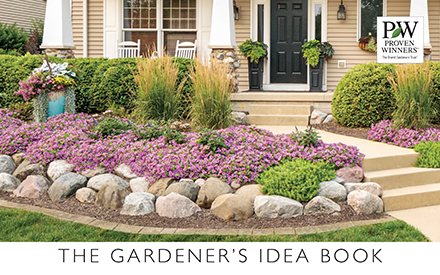Pruning Shrubs Demystified - The Guide to Why, When, and How
Pruning shrubs may seem daunting, but mastering the basic principles behind the why, when, and how makes it a simple and rewarding process.
 What’s the secret of transitioning from a competent gardener to a confident one? Pruning! Though pruning shrubs strikes fear into the hearts of many, it is actually a simple and rewarding process. All you need to do to master it is to understand a few basic principles behind the why, when, and how of pruning shrubs. Once you implement these ideas and techniques, you’ll have more flowers and healthier plants in your garden that same season.
What’s the secret of transitioning from a competent gardener to a confident one? Pruning! Though pruning shrubs strikes fear into the hearts of many, it is actually a simple and rewarding process. All you need to do to master it is to understand a few basic principles behind the why, when, and how of pruning shrubs. Once you implement these ideas and techniques, you’ll have more flowers and healthier plants in your garden that same season.
Why should I prune a shrub?
When in doubt, don’t prune! Most shrubs don’t require regular pruning in order to be healthy and beautiful.
When you consider pruning a shrub in your yard, first ask yourself why you want to prune it. Every subsequent decision you’ll make in pruning depends on the reason why you are pruning in the first place, so never prune without a reason.
Reasons you may want to prune a shrub:
- Improve flowering and fruiting
- Improve stem color on plants like dogwood
- Improve the plant’s habit or shape
- Encourage rebloom
- Neaten a plant’s appearance by removing old blooms or wayward shoots
- Rejuvenate or shorten an over-grown shrub
- Create a special feature, like a topiary or formal hedge
TIP! Most shrubs have an appealing natural habit that doesn’t require extensive trimming and shaping. Enjoy your low-maintenance landscape and only prune when necessary.
Learn more: Pruning Shrubs, Part 1 - Why Prune
How do I prune a shrub?
- Use a pair of sharp bypass pruners for the job. Their scissor-like action makes nice clean cuts.
- Cut stems back to just above a big bud or set of buds. The bigger the bud you cut back to, the thicker and more vigorous the growth that comes from it will be.
- When cutting a stem back, avoid cutting into heavy wood where you can’t see any buds.
- Make pruning cuts as small as possible by cutting stems straight across instead of on an angle. This ensures speedy healing.
- Aim to remove about one-third of the plant when pruning. There are two main approaches:

1. Cut back the entire plant more or less evenly.
This shortens the stems and ensures that the growth for the year comes from big, vigorous buds further down on the plant.
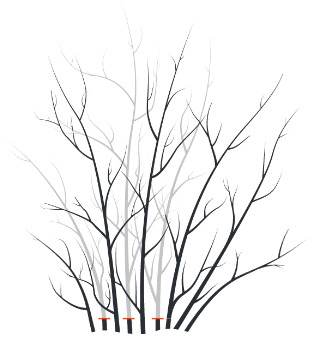
2. Remove selected stems entirely.
This encourages new growth from the base of the plant, improving the health and habit.
Learn more: Pruning Shrubs, Part 3 - How to Prune
Watch more pruning videos on the Proven Winners ColorChoice Flowering Shrubs YouTube channel.
What pruning tools should I use?
Bypass pruners are ideal for trimming roses, hydrangeas, and similar plants, while hedge shears are ideal for shaping boxwoods. For larger branches, a hand saw or loppers can be employed to make quick and clean cuts.
When do I prune a shrub?
The answer to this depends on whether the shrub in question blooms on old wood or on new wood.
Old woodShrubs that bloom on old wood create their flower buds for the next year almost as soon as they finish blooming during the current year. Shrubs that bloom on old wood have flower buds present for most of the year.
Plants that bloom on old wood should only be pruned immediately after they flower:
Generally speaking, the earlier in spring a plant blooms, the more likely it flowers on old wood. If you are willing to forgo flowers for a year, it's okay to prune shrubs that bloom on old wood in spring. | New woodShrubs that bloom on new wood create their flower buds for the year after new growth has begun in spring. Shrubs that bloom on new wood have flower buds present only during the growing season.
Plants that bloom on new wood may be pruned in spring:
Try to time pruning such plants so you do it just as the new growth is beginning to emerge on the stems—this allows you to see exactly where healthy new growth is occurring.
|
Learn more: Pruning Shrubs, Part 2 - When is the Best Time to Prune?
Special Cases
- Reblooming plants like Bloomerang® lilac and Bloom-A-Thon® azalea flower on both old wood and on new wood – if they require pruning, the best time to do it is immediately after their spring bloom.
- Evergreens like arborvitae and boxwood are best pruned in spring, after new growth has flushed out.
- Dead wood can be removed any time. Branches that cause a hazard to people, pets, or property should be removed promptly.
Avoid Pruning
For best performance, it’s best to avoid pruning the following plants, except to remove dead wood in spring:
- Bigleaf hydrangea
- Mountain hydrangea
- Oakleaf hydrangea
- Rhododendron
- Viburnums grown for their berries
- Winterberry holly
Learn more: Pruning Shrubs, Part 4 - A Plant by Plant Guide
Pruning Demystified - Download Printable PDF
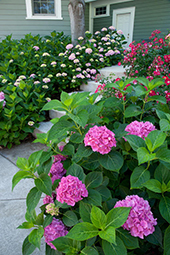 |  | 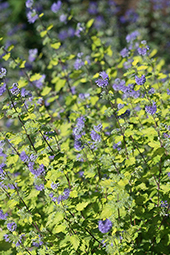 Keep Calm and Prune Dead Wood (Help for Shrubs with Winter Damage) | 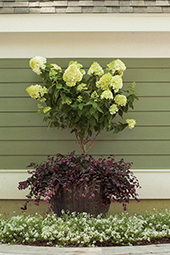 | 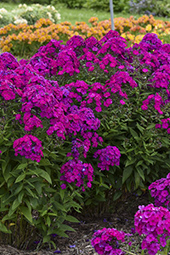 |
YOU ARE ALWAYS WELCOME TO CONTACT US WITH QUESTIONS – VISIT WWW.PROVENWINNERS.COM/FEEDBACK.







